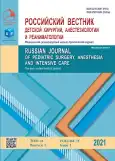Long-term results of treatment of newborns and infants with necrosis and perforation of the stomach and duodenum
- Authors: Skopetc A.A.1,2, Karavaeva S.A.1,2, Nemilova T.K.2,3
-
Affiliations:
- I.I. Mechnikov North-Western State Medical University
- Children’s city multidisciplinary clinical specialized center for high medical technologies
- Academican I.P. Pavlov First St. Petersburg State Medical University, Saint Petersburg
- Issue: Vol 11, No 1 (2021)
- Pages: 7-16
- Section: Original Study Articles
- URL: https://journals.rcsi.science/2219-4061/article/view/123475
- DOI: https://doi.org/10.17816/psaic718
- ID: 123475
Cite item
Full Text
Abstract
INTRODUCTION: Necrosis and perforation of the stomach and /or duodenum in newborns and infants is a rare but severe disease with high mortality. There are many theories about the etiology and pathogenesis of the necrosis and perforation of the stomach and duodenum in children of this age. Various treatment options are described, but neither foreign nor Russian publications have assessed the long-term results of the treatment of patients with perforation of the stomach and duodenum during the first year of life and the quality of their life.
AIM: This study aimed to analyze the results of treatment of newborns and infants with perforation of the stomach and duodenum and to assess their long-term quality of life.
MATERIALS AND METHODS: The study analyzes the long-term results of treatment of 21 children, aged 2–12 yrs, with perforation of the stomach and duodenum. The volumetric evacuation function of the stomach and duodenum and the child’s nutritional status were assessed. A survey of patients and their parents was also carried out to assess the quality of life of the child using questionnaires from the EuroQol Research Foundation version EQ5D-Y.
RESULTS: The volumetric evacuation function of the stomach and duodenum recovered completely. The nutritional status of 16 (76%) children corresponds to their age. According to the results of the analysis of the questionnaire of the quality of life, eight patients aged >8 yrs and 15 parents consider the health profile of children as the best (71%), the parents of one patient assess the health profile of their child as satisfactory, and five mothers of children with neurological deficits rated as unsatisfactory.
CONCLUSION: Owing to the high adaptation capacity of the newborn and infants of the first year of life, most of the examined patients have a good quality of life and a normal nutritional status. The volumetric evacuation function of the stomach and duodenum recovered in all patients within 1–3 yrs after surgery.
Keywords
Full Text
##article.viewOnOriginalSite##About the authors
Anastasiia A. Skopetc
I.I. Mechnikov North-Western State Medical University; Children’s city multidisciplinary clinical specialized center for high medical technologies
Author for correspondence.
Email: anastasiya.sk@inbox.ru
ORCID iD: 0000-0001-8831-4693
pediatric surgeon, postgraduate student
Russian Federation, 14 Avangardnaya str., Saint Petersburg, 198205Svetlana A. Karavaeva
I.I. Mechnikov North-Western State Medical University; Children’s city multidisciplinary clinical specialized center for high medical technologies
Email: svetlana.karavaeva@szgmu.ru
ORCID iD: 0000-0001-5884-9128
SPIN-code: 4224-5532
Dr. Sci. (Med.), Professor
Russian Federation, 14 Avangardnaya str., Saint Petersburg, 198205Tatiana K. Nemilova
Children’s city multidisciplinary clinical specialized center for high medical technologies; Academican I.P. Pavlov First St. Petersburg State Medical University, Saint Petersburg
Email: nemilova@mail.ru
ORCID iD: 0000-0002-0922-0638
SPIN-code: 6961-6633
Dr. Sci. (Med.), Professor
Russian Federation, 14 Avangardnaya str., Saint Petersburg, 198205References
- Byun J, Kim HY, Noh SY, et al. Neonatal gastric perforation: A single center experience. World J Gastrointest Surg. 2014;6(8):151–155. doi: 10.4240/wjgs.v6.i8.151
- Chen T-Y, Liu H-K, Yang M-C, et al. Neonatal gastric perforation: a report of two cases and a systematic review. Medicine (Baltimore). 2018;97(17):369–373. DOI: 1097/MD.0000000000010369
- Kara CS, Ilçe Z, Celayir S, et al. Neonatal gastric perforation: review of 23 years’ experience. Surg Today. 2004;34(3):243–245. doi: 10.1007/s00595-003-2675-3
- Gumerov AA, Bayazitov RR, Neudachin AE, et al. Gastric perforation in newborns. Medical Bulletin of Bashkortostan. 2018;13(4):53–66. (In Russ.)
- Farrugia M.K. Neonatal gastrointestinal perforation. Arch Dis Child Fetal Neonatal Ed. 2003;88(1):75–76. doi: 10.1136/fn.88.1.F75
- Lee DK, Shim SY, Cho SJ, et al. Comparison of gastric and other bowel perforations in preterm infants: a review of 20 years’ experience in a single institution. Korean J Pediatr. 2015;58(8):288–293. doi: 10.3345/kjp.2015.58.8.288
- Terui K, Iwai J, Yamada S, et al. Etiology of neonatal gastric perforation: a review of 20 years’ experience. Pediatr Surg Int. 2012;28(1):9–14. doi: 10.1007/s00383-011-3003-4
- Podkamenev VV, Novozhilov VA, Podkamenev AV, Timofeev DV. Gastric perforation in newborns. Pediatric surgery. 2003;(6):9–11. (In Russ.)
- Aydin M, Deveci U, Taskin E, et al. Percutaneous peritoneal drainage in isolated neonatal gastric perforation. World J Gastroenterol. 2015;21(45):12987–12988. doi: 10.3748/wjg.v21.i45.12987
- Jawad AJ, Al-Rabie A, Hadi A. Spontaneous neonatal gastric perforation. Pediatr Surg Int. 2002;18(5-6):396–399. doi: 10.1007/s00383-002-0749-8
- Tiwari C, Sandlas G, Jayaswal S, Shah H. Spontaneous intestinal perforation in neonates. J. Neonatal Surg. 2015;4(2):14.
- Leone RJ, Krasna IH. Spontaneous’ neonatal gastric perforation: Is it really spontaneous? J Pediatr Surg. 2000;35(7):1066–1069. doi: 10.1053/jpsu.2000.7773
- Averin VI, Svirsky AA, Anisimova EV. Spontaneous rupture of the stomach in newborns. Surgery. Eastern Europe. Application. 2013;47–49. (In Russ.)
- Iacusso C, Boscarelli A, Fusaro F, et al. Pathogenetic and Prognostic Factors for Neonatal Gastric Perforation: Personal Experience and Systematic Review of the Literature. Front Pediatr. 2018;6:61. doi: 10.3389/fped.2018.00061
- Durham MM, Ricketts RR. Neonatal gastric perforation and necrosis with Hunt-Lawrence pouch reconstruction. J Pediatr Surg. 1999;34(4):649–651. doi: 10.1016/S0022-3468(99)90097-0
- Shabalov NP. Pediatric gastroenterology. A guide for doctors. 3rd ed., rev. and add. Moscow: MEDpress-Inform. 2019. P. 304–344. (In Russ.)
Supplementary files













